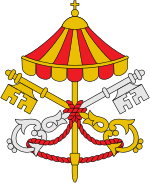Papal conclave, 1667

Coat of arms during the vacancy of the Holy See
|
|
| Dates and location | |
|---|---|
| 2–20 June 1667 Apostolic Palace, Papal States |
|
| Key officials | |
| Dean | Francesco Barberini |
| Sub-Dean | Marzio Ginetti |
| Camerlengo | Antonio Barberini |
| Protopriest | Ernst Adalbert von Harrach |
| Protodeacon | Rinaldo d'Este |
| Elected Pope | |
|
Giulio Rospigliosi (Name taken: Clement IX) |
|
 |
|
The Papal conclave, 1667 (June 2–20, 1667) to determine the successor to Pope Alexander VII resulted in the election of cardinal Giulio Rospigliosi, who took the name of Clement IX.
Pope Alexander VII died on May 22, 1667, at the age of 68. At the time of his death, there were 70 cardinals in the Sacred College, but two of them died during sede vacante, and another four were entirely absent, leaving the number of 64 participants.
The College of Cardinals was divided into several factions. The strongest of them was the party of Flavio Chigi, cardinal-nephew of Pope Alexander VII, which grouped 24 of his creatures. Another influential person was dean of the College, Francesco Barberini, who was leader of the group of old cardinals created by his uncle Urban VIII. Small but important because of the possibility of using the right of exclusion were the factions of the so-called "Crown-Cardinals", of Spain and France. They represented the respective interests of Charles II of Spain and Louis XIV of France.
The French party was instructed to work for the election of cardinal Secretary of State Giulio Rospigliosi. They thought that Rospigliosi, as former nuncio in Madrid, would be also acceptable for Spain. France had in Rome a clever and active ambassador in the duc de Chaulnes, who had replaced the duc de Créqui at Palazzo Farnese in 1665 and closely cooperated with Cardinal de Retz, the main representative of France in the Sacred College.
...
Wikipedia
